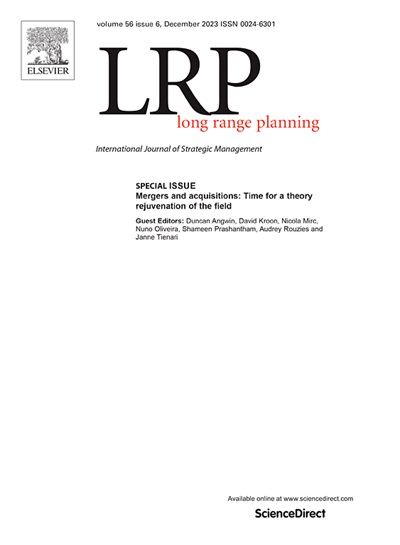Multiple goal conflicts and exploratory innovation: Does alignment between team and organization help or hurt?
IF 6.3
2区 管理学
Q1 BUSINESS
引用次数: 0
Abstract
This study examines the varying impacts of multiple goal conflicts on employees' exploratory innovative behaviors. Although innovation is vital for an organization's survival and competitive advantage, the simultaneous pursuit of other goals may create goal conflicts for employees: increasing pressure on their scarce resources, including time and cognitive capacity. While much of the existing research discusses goal conflicts in general or emphasizes their negative performance consequences, we extend this literature by theorizing about two distinct ways individuals may interpret goal conflicts—either as a trade-off (e.g., innovation vs. revenue) or as complementary (e.g., innovation vs. safety)—and how these interpretations affect exploratory innovation. Moreover, we theorize that team–organization alignment moderates these effects. Our findings, based on multilevel, multisource, time-lagged data from a large energy company, indicate that conflicts involving innovation goals do not uniformly impact employee exploratory behavior. Increasing levels of conflict between innovation and safety goals are associated with employees conducting more innovation activities, but the expected negative effect of innovation-revenue conflicts is insignificant. Moreover, in a context of high alignment the innovation-safety conflict triggers employees to innovate more; in contrast, for the innovation-revenue conflict it is the opposite. Our study offers important implications for the literature on multiple goal conflict and highlights the critical roles of employees and their alignment with senior leadership.
多目标冲突和探索性创新:团队和组织之间的一致性是有益还是有害?
本研究考察了多目标冲突对员工探索性创新行为的不同影响。虽然创新对组织的生存和竞争优势至关重要,但同时追求其他目标可能会给员工带来目标冲突:增加他们稀缺资源(包括时间和认知能力)的压力。虽然现有的许多研究一般讨论目标冲突或强调其负面绩效后果,但我们通过理论化个人可能解释目标冲突的两种不同方式来扩展这些文献-要么作为权衡(例如,创新与收入),要么作为补充(例如,创新与安全)-以及这些解释如何影响探索性创新。此外,我们的理论认为,团队与组织的一致性调节了这些影响。我们的研究结果基于一家大型能源公司的多层次、多源、时滞数据,表明涉及创新目标的冲突对员工探索行为的影响并不一致。创新与安全目标冲突程度的增加与员工进行更多的创新活动有关,但创新与收益冲突的预期负面影响不显著。此外,在高一致性背景下,创新安全冲突会激发员工更多的创新;相反,对于创新与收入的冲突,情况正好相反。本研究为多目标冲突的研究提供了重要启示,并突出了员工的关键角色及其与高层领导的一致性。
本文章由计算机程序翻译,如有差异,请以英文原文为准。
求助全文
约1分钟内获得全文
求助全文
来源期刊

Long Range Planning
Multiple-
CiteScore
13.00
自引率
7.10%
发文量
75
期刊介绍:
Long Range Planning (LRP) is an internationally renowned journal specializing in the field of strategic management. Since its establishment in 1968, the journal has consistently published original research, garnering a strong reputation among academics. LRP actively encourages the submission of articles that involve empirical research and theoretical perspectives, including studies that provide critical assessments and analysis of the current state of knowledge in crucial strategic areas. The primary user base of LRP primarily comprises individuals from academic backgrounds, with the journal playing a dual role within this community. Firstly, it serves as a platform for the dissemination of research findings among academic researchers. Secondly, it serves as a channel for the transmission of ideas that can be effectively utilized in educational settings. The articles published in LRP cater to a diverse audience, including practicing managers and students in professional programs. While some articles may focus on practical applications, others may primarily target academic researchers. LRP adopts an inclusive approach to empirical research, accepting studies that draw on various methodologies such as primary survey data, archival data, case studies, and recognized approaches to data collection.
 求助内容:
求助内容: 应助结果提醒方式:
应助结果提醒方式:


